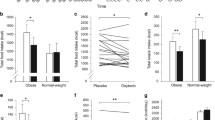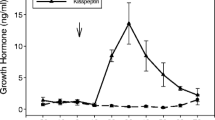Abstract
ACTH, βlipotropin (βLPH), βendorphin (βEP), Prolactin (PRL) and Cortisol were measured in the first five days of Puerperium at 9:00, before and 30 minutes after suckling, in 7 healthy lactating women. With the exception of PRL plasma levels which decline, although remaining at high concentrations during the observation period, all the other parameters showed a sudden fall from the high levels found at delivery, reaching stable normal levels (βLPH, βEP, Cortisol) or concentrations which were 50% lower than normal (ACTH), from the second day of Puerperium. Suckling confirms its capacity to release plasma PRL, while all the other indices remain unmodified. Despite the experimental evidence that serotoninergic neurons are involved both in the PRL response to suckling and the circadian rhythmicity and stress response of proopiocortin-related peptides, the present results suggest that breast feeding is not a stressful situation, as no typical proopiocortin-related peptide response is evident, and that the activation of PRL release is related to stimulation of serotoninergic neurons which differ from those involved in the control of proopiocortin-related peptide secretion.
Similar content being viewed by others
References
Müller E.E., Nisticò G., Scapagnini U. Neurotransmitters and anterior pituitary function. Academic Press, New York, 1977.
Jones M.T., Gilham B., Di Renzo G., Beckford U., Holmes M.C. Neural control of corticotrophin secretion. Front. Horm. Res. 8: 12, 1981.
Noel G.L., Suh H.K., Stone J.G., Frantz A.G. Human prolactin and GH release during surgery and other conditions of stress. J. Clin. Endocrinol. Metab. 35: 840, 1972.
Krieger D.T., Liotta A., Suda T., Goodgold A.N., Condon E. Human plasma immunoreactive βLPH and adrenocorti-cotropin in normal subjects and in patients with pituitary-adrenal disease. J. Clin. Endocrinol. Metab. 48: 566, 1979.
Labrie F., Cusan L., Dupont A., Ferland L., Lemay A. Opioids and anterior pituitary hormone secretion. In: Van Ree J.M., Terenius L. (Eds.), Characteristics and function of opioids. Elsevier/North Holland Biomedical Press, Amsterdam, 1978, p. 333.
Mains R., Eipper B., Ling N. Common precursor to corticotropins and endorphins. Proc. Natl. Acad. Sci. USA 74: 3014, 1977.
Guillemin R., Vargo T., Rossier J., Minick S., Ling N., Rivier C., Vale W., Bloom F. βEP and adrenocorticotropin are secreted concomitantly by the pituitary gland. Science 197: 1367, 1977.
Kordon C., Blake C.A., Terkel J., Sawyer C.H. Participation of serotonin-containing neurons in the suckling-induced rise in plasma prolactin levels in lac-tating rats. Neuroendocrinology 13: 213, 1974.
Delitala G., Lodico G., Masala A., Alagna S., Devilla L. Action of metergoline in suppressing prolactin release induced by mechanical breast emptying. J. Clin. Endocrinol. Metab. 41: 763, 1977.
Genazzani A.R., Fraioli F., Conti C., Fioretti P. Methodological problems and clinical validity of an ACTH radioimmunoassay method applied to extracted plasma samples. J.Nucl. Biol. Med. 78:67, 1974.
Facchinetti F., Genazzani A.R. Simultaneous radioimmunoassay of β LPH and β EP in human plasma. In: Albertini A., Da Prada M., Peskar B.A. (Eds.), Radioimmunoassay of drugs and hormones in cardiovascular medicine. Elsevier/North Holland Biomedical Press, Amsterdam, 1979, p. 347.
Greenwood F.C., Hunter W.M., Glover J.S. The preparation of 131l labelled in human growth hormone of high specific radioactivity. Biochem. J. 89: 114, 1962.
Fraioli F., Genazzani A.R. Human placental /SEP Gynecol. Obstet. Invest. 11: 37, 1980.
Genazzani A.R., Facchinetti F., Parrini D. β-lipotrophin and β-endorphin plasma levels during pregnancy. Clin. Endocrinol. (Oxf.) 14: 409, 1981.
Reyes F.I., Winter J.S.D., Faiman C. Pituitary-ovarian inter-relationship during the Puerperium. Am. J. Obstet. Gynecol. 114: 589, 1972.
Yen S.S.C., Samaan N., Pearson O.H. Growth hormone levels in pregnancy. J. Clin. Endocrinol. Metab. 27: 1341, 1967.
Liotta A., Li C.H., Schussler G.C., Krieger D.T. Comparative metabolic clearance rate, volume of distribution and plasma half-life of human βLPH and ACTH Life Sci. 23: 2323, 1978.
Genazzani A.R., Fraioli F., Hurlimann J., Fioretti P., Felber J.P. Immunoreactive ACTH and Cortisol plasma levels during pregnancy. Detection and partial purification of corticotrophin-like placental hormone: the human chorionic cortitrophin (HCC). Clin. Endocrinol. (Oxf.) 4: 1, 1975.
Rosenthal H.E., Slaunwhite W.R.J., Sandberg A.A. Transcortin: a corticosteroid-binding protein of plasma. Cortisol and progesterone interplay and unbound levels of these steroids in pregnancy. J. Clin. Endocrinol. Metab. 29: 95, 1969.
Tuchinsky D. The postpartum period In: Tukchinsky D., Ryan K.J. (Eds.), Maternal-fetal endocrinology. W.B. Saunder Co., Philadelphia, 1980, p. 144.
Silman R.E., Holland D., Chard T., Lowry P.J., Hope J., Robinson J.S., Thorburn G.D. The ACTH “family tree” of the rhesus monkey changes with development. Nature 276: 526, 1978.
Imura H., Nakai Y., Nako K., Oki S., Tanaka I., Kinoshita F., Tsukada T., Yoshima T. Biosynthesis and regulation of secretion of ACTH, β-endorphin and related peptides. International Symposium on Pituitary Hormones and related peptides. Republic of S. Marino, May 25–27, 1981, p. 36 (Abstract).
Noel G.L., Suh H.K., Frantz A.G. Prolactin release during nursing and breast stimulation in post-partum and non-postpartum subjects. J. Clin. Endocrinol. Metab. 38: 413, 1974.
Author information
Authors and Affiliations
Additional information
Supported by CNR-Endocrinology group.
Rights and permissions
About this article
Cite this article
Genazzani, A.R., Facchinetti, F., Parrini, D. et al. Puerperal breast feeding does not stimulate circulating opioids in humans. J Endocrinol Invest 5, 367–371 (1982). https://doi.org/10.1007/BF03350534
Received:
Accepted:
Published:
Issue Date:
DOI: https://doi.org/10.1007/BF03350534




